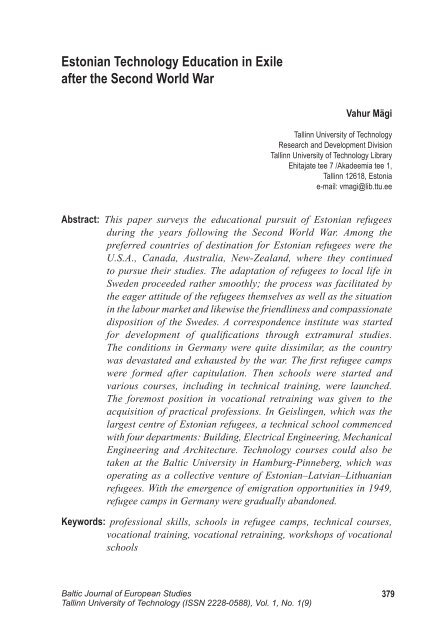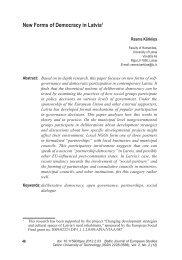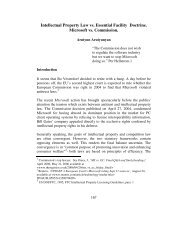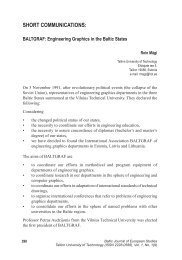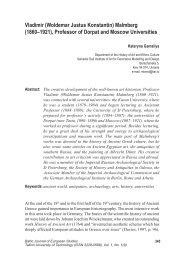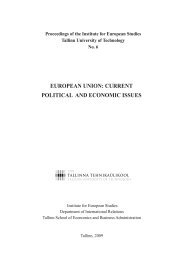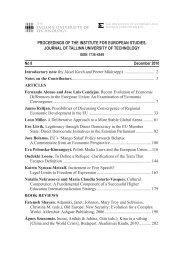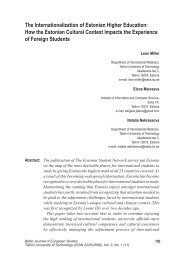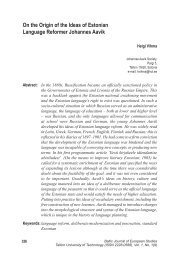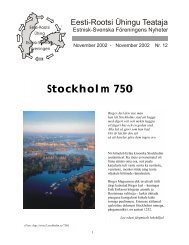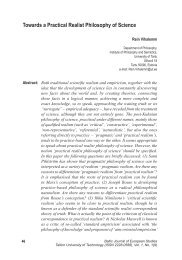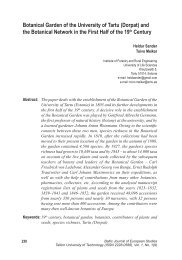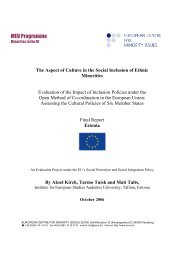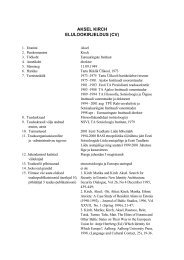Estonian technology Education in Exile after the Second World War
Estonian technology Education in Exile after the Second World War
Estonian technology Education in Exile after the Second World War
Create successful ePaper yourself
Turn your PDF publications into a flip-book with our unique Google optimized e-Paper software.
<strong>Estonian</strong> Technology <strong>Education</strong> <strong>in</strong> <strong>Exile</strong><br />
<strong>after</strong> <strong>the</strong> <strong>Second</strong> <strong>World</strong> <strong>War</strong><br />
<strong>Estonian</strong> Technology <strong>Education</strong> <strong>in</strong> <strong>Exile</strong><br />
<strong>after</strong> <strong>the</strong> <strong>Second</strong> <strong>World</strong> <strong>War</strong><br />
Vahur Mägi<br />
Tall<strong>in</strong>n University of Technology<br />
Research and Development Division<br />
Tall<strong>in</strong>n University of Technology Library<br />
Ehitajate tee 7 /Akadeemia tee 1,<br />
Tall<strong>in</strong>n 12618, Estonia<br />
e-mail: vmagi@lib.ttu.ee<br />
Abstract: This paper surveys <strong>the</strong> educational pursuit of <strong>Estonian</strong> refugees<br />
dur<strong>in</strong>g <strong>the</strong> years follow<strong>in</strong>g <strong>the</strong> <strong>Second</strong> <strong>World</strong> <strong>War</strong>. Among <strong>the</strong><br />
preferred countries of dest<strong>in</strong>ation for <strong>Estonian</strong> refugees were <strong>the</strong><br />
U.S.A., Canada, Australia, New-Zealand, where <strong>the</strong>y cont<strong>in</strong>ued<br />
to pursue <strong>the</strong>ir studies. The adaptation of refugees to local life <strong>in</strong><br />
Sweden proceeded ra<strong>the</strong>r smoothly; <strong>the</strong> process was facilitated by<br />
<strong>the</strong> eager attitude of <strong>the</strong> refugees <strong>the</strong>mselves as well as <strong>the</strong> situation<br />
<strong>in</strong> <strong>the</strong> labour market and likewise <strong>the</strong> friendl<strong>in</strong>ess and compassionate<br />
disposition of <strong>the</strong> Swedes. A correspondence <strong>in</strong>stitute was started<br />
for development of qualifications through extramural studies.<br />
The conditions <strong>in</strong> Germany were quite dissimilar, as <strong>the</strong> country<br />
was devastated and exhausted by <strong>the</strong> war. The first refugee camps<br />
were formed <strong>after</strong> capitulation. Then schools were started and<br />
various courses, <strong>in</strong>clud<strong>in</strong>g <strong>in</strong> technical tra<strong>in</strong><strong>in</strong>g, were launched.<br />
The foremost position <strong>in</strong> vocational retra<strong>in</strong><strong>in</strong>g was given to <strong>the</strong><br />
acquisition of practical professions. In Geisl<strong>in</strong>gen, which was <strong>the</strong><br />
largest centre of <strong>Estonian</strong> refugees, a technical school commenced<br />
with four departments: Build<strong>in</strong>g, Electrical Eng<strong>in</strong>eer<strong>in</strong>g, Mechanical<br />
Eng<strong>in</strong>eer<strong>in</strong>g and Architecture. Technology courses could also be<br />
taken at <strong>the</strong> Baltic University <strong>in</strong> Hamburg-P<strong>in</strong>neberg, which was<br />
operat<strong>in</strong>g as a collective venture of <strong>Estonian</strong>–Latvian–Lithuanian<br />
refugees. With <strong>the</strong> emergence of emigration opportunities <strong>in</strong> 1949,<br />
refugee camps <strong>in</strong> Germany were gradually abandoned.<br />
Keywords: professional skills, schools <strong>in</strong> refugee camps, technical courses,<br />
vocational tra<strong>in</strong><strong>in</strong>g, vocational retra<strong>in</strong><strong>in</strong>g, workshops of vocational<br />
schools<br />
Baltic Journal of European Studies<br />
Tall<strong>in</strong>n University of Technology (ISSN 2228-0588), Vol. 1, No. 1(9)<br />
379
Vahur Mägi<br />
In <strong>the</strong> autumn of 1944, about seventy-five to n<strong>in</strong>ety thousand people left<br />
Estonia for western countries to flee from <strong>the</strong> new Russian occupation. They<br />
were ma<strong>in</strong>ly headed to Germany and Sweden. Accord<strong>in</strong>g to different authors, as<br />
many as forty to fifty thousand <strong>Estonian</strong>s reached Germany and its neighbour<strong>in</strong>g<br />
regions with<strong>in</strong> <strong>the</strong> wave of refugees. Thirty thousand <strong>Estonian</strong> refugees arrived<br />
<strong>in</strong> Sweden ei<strong>the</strong>r by boat straight across <strong>the</strong> Baltic Sea or through F<strong>in</strong>land<br />
(Kumer-Haukanõmm, 2006). The majority of refugees to arrive <strong>in</strong> Sweden were<br />
compelled to settle <strong>in</strong> camps. As <strong>the</strong>y did not have command of <strong>the</strong> Swedish<br />
language, f<strong>in</strong>d<strong>in</strong>g a job was difficult for <strong>the</strong>m at <strong>the</strong> start. As a rule seek<strong>in</strong>g a<br />
solution for <strong>the</strong>ir language problem rema<strong>in</strong>ed a concern of <strong>the</strong> camp <strong>in</strong>habitants<br />
<strong>the</strong>mselves, whereas courses for learn<strong>in</strong>g <strong>the</strong> Swedish language were arranged<br />
only <strong>in</strong> few places (Andræ, 2005, pp. 183–184).<br />
The study of language was supported by expeditiously issued dictionaries,<br />
among which <strong>the</strong> great Swedish–<strong>Estonian</strong> dictionary by Per Wieselgren, Paul<br />
Ariste and Gustav Suits had already been completed dur<strong>in</strong>g <strong>the</strong> prewar period<br />
<strong>in</strong> Estonia. Sweden had succeeded <strong>in</strong> gett<strong>in</strong>g out of <strong>the</strong> war <strong>in</strong> a better condition<br />
than o<strong>the</strong>r states – <strong>the</strong> country was not destroyed, human resources were <strong>in</strong>tact,<br />
a few difficulties with raw materials and energy were however encountered.<br />
The lack of workers impeded procurement of wood from forests, while quite a<br />
number of men were drawn away from work <strong>in</strong> <strong>the</strong> <strong>in</strong>terest of territorial defense.<br />
Thus forestry appeared as <strong>the</strong> first field of activity to provide employment for<br />
<strong>the</strong> <strong>Estonian</strong>s. Lumbermen teams were formed and tra<strong>in</strong><strong>in</strong>g courses for timber<br />
harvest<strong>in</strong>g conducted <strong>in</strong> <strong>the</strong> camps. A great number of <strong>Estonian</strong>s moved to<br />
manufactur<strong>in</strong>g towns. The first position <strong>in</strong> terms of refugee employment was<br />
held by <strong>the</strong> textile <strong>in</strong>dustry, which was followed by <strong>the</strong> metallurgical <strong>in</strong>dustry.<br />
With <strong>the</strong> improvement of <strong>the</strong>ir l<strong>in</strong>guistic and vocational skills <strong>Estonian</strong>s could<br />
more frequently be encountered at construction sites as well. Large centres of<br />
<strong>Estonian</strong>s sprang up <strong>in</strong> Eskilstuna, Go<strong>the</strong>nburg, Södertälje and Uddevalla. They<br />
could not depend upon <strong>the</strong> knowledge and expertise brought along from <strong>the</strong> home<br />
country. Practical skills were evidently more appreciated and hereby preparation<br />
for real work was specifically put to <strong>the</strong> foremost position <strong>in</strong> <strong>the</strong> vocational<br />
retra<strong>in</strong><strong>in</strong>g of refugees. F<strong>in</strong>d<strong>in</strong>g some k<strong>in</strong>d of a job was easy for skilled workers.<br />
Eng<strong>in</strong>eers, doctors, pharmacists and veter<strong>in</strong>arians were also do<strong>in</strong>g well. O<strong>the</strong>r<br />
educated people had to earn <strong>the</strong>ir daily bread with poorly paid archival work<br />
(Rootsi…, 1946). The first <strong>Estonian</strong> schools <strong>in</strong> refugee camps commenced <strong>the</strong>ir<br />
activities as early as <strong>in</strong> September of 1944. An <strong>Estonian</strong>-language newspaper<br />
Teataja, issued <strong>in</strong> Sweden, <strong>in</strong>formed its readers that more than two thousand<br />
elementary school students, close to eight hundred high school students and<br />
approximately four hundred teachers had arrived <strong>in</strong> <strong>the</strong> country. Over fifty<br />
380<br />
Baltic Journal of European Studies<br />
Tall<strong>in</strong>n University of Technology (ISSN 2228-0588), Vol. 1, No. 1(9)
<strong>Estonian</strong> Technology <strong>Education</strong> <strong>in</strong> <strong>Exile</strong><br />
<strong>after</strong> <strong>the</strong> <strong>Second</strong> <strong>World</strong> <strong>War</strong><br />
schools <strong>in</strong> various camps had commenced <strong>the</strong>ir activities by next spr<strong>in</strong>g, with<br />
a thousand or so students acquir<strong>in</strong>g <strong>Estonian</strong>-language education. The number<br />
of teachers work<strong>in</strong>g <strong>in</strong> <strong>the</strong> schools of various camps was somewhere around<br />
a hundred. <strong>Estonian</strong>-language schools were opened outside refugee camps as<br />
well.<br />
The conditions <strong>in</strong> Germany were somewhat more complicated for refugees. They<br />
had to move around <strong>in</strong> search of a place to live and work while <strong>the</strong> war was still<br />
on. The first refugee camps were formed no earlier than <strong>after</strong> <strong>the</strong> capitulation<br />
<strong>in</strong> <strong>the</strong> spr<strong>in</strong>g of 1945. Even <strong>the</strong>re <strong>the</strong> refugees led <strong>the</strong>ir lives under constant<br />
fear of be<strong>in</strong>g extradited to <strong>the</strong> Russians. The situation was easier for skilled<br />
laborers, among <strong>the</strong>m <strong>the</strong> greatest need was for metalworkers, electricians,<br />
lumbermen, builders, textile workers, m<strong>in</strong>ers, shipbuilders, as well as workers<br />
at paper mills and glassworks. The gazettes of refugee camps compla<strong>in</strong>ed that<br />
educated people did not have much chance to succeed and advised to grasp<br />
even <strong>the</strong> slightest opportunities to obta<strong>in</strong> practical skills (Intelligents…, 1947).<br />
Form<strong>in</strong>g of <strong>the</strong> <strong>Estonian</strong> Committees was started <strong>in</strong> <strong>the</strong> spr<strong>in</strong>g of 1945, <strong>the</strong><br />
earliest among <strong>the</strong>m were assembled <strong>in</strong> Gotha and Detmold. The activities of<br />
<strong>the</strong> United Nations Relief and Rehabilitation Adm<strong>in</strong>istration (UNRRA) towards<br />
organiz<strong>in</strong>g DP (displaced person) camps were helpful. The UNRRA plans did<br />
not <strong>in</strong>clude a provision on educat<strong>in</strong>g <strong>the</strong> children as it was assumed that <strong>the</strong><br />
refugees would return to <strong>the</strong>ir home country before long. When it became<br />
evident that repatriation of <strong>the</strong> people from <strong>the</strong> Baltic States was not possible,<br />
<strong>the</strong>ir attitude towards schools became more understand<strong>in</strong>g, even to <strong>the</strong> extent<br />
that <strong>the</strong> establishment of quite a few schools progressed smoothly namely thanks<br />
to <strong>the</strong> assistance of <strong>the</strong> UNRRA officers.<br />
Establishment of schools was first started <strong>in</strong> <strong>the</strong> British zone. Six <strong>Estonian</strong><br />
elementary schools were operat<strong>in</strong>g <strong>the</strong>re as early as <strong>in</strong> June 1945, where of<br />
<strong>the</strong> earliest was opened <strong>in</strong> Schwarzenbek. As <strong>the</strong> number of <strong>Estonian</strong>s <strong>in</strong> <strong>the</strong><br />
British zone was smaller than <strong>in</strong> <strong>the</strong> American zone, it comprised multiple m<strong>in</strong>or<br />
camps, on account of which schools also rema<strong>in</strong>ed quite small. 24 <strong>Estonian</strong><br />
schools with 620 students and seven high schools with 260 students had been<br />
registered by <strong>the</strong> follow<strong>in</strong>g autumn and <strong>the</strong> number of students showed slight<br />
growth later on.<br />
Schools <strong>in</strong> <strong>the</strong> American zone commenced <strong>the</strong>ir activities from <strong>the</strong> autumn<br />
of 1945. Earlier than elsewhere, educational activities were started <strong>in</strong> Hanau<br />
and Memm<strong>in</strong>gen. One of <strong>the</strong> best-known <strong>Estonian</strong> schools <strong>in</strong> Germany – <strong>the</strong><br />
Augsburg High School – was started <strong>in</strong> <strong>the</strong> <strong>Estonian</strong> DP camp Augsburg-<br />
Hochfeld at <strong>the</strong> beg<strong>in</strong>n<strong>in</strong>g of August. More than anyth<strong>in</strong>g else <strong>the</strong> schoolwork<br />
Baltic Journal of European Studies<br />
Tall<strong>in</strong>n University of Technology (ISSN 2228-0588), Vol. 1, No. 1(9)<br />
381
Vahur Mägi<br />
was hampered by lack of textbooks. A proposal was made to <strong>the</strong> UNRRA for<br />
publish<strong>in</strong>g ma<strong>the</strong>matics textbooks. Schoolbooks, which had been published<br />
<strong>in</strong> Estonia were widely used as textbooks and reproduced accord<strong>in</strong>g to need<br />
(Kool, 1999, p. 716). However, this could not rema<strong>in</strong> <strong>the</strong> only th<strong>in</strong>g to rely on.<br />
Textbooks for reproduction were lack<strong>in</strong>g <strong>in</strong> a number of specialties. Teachers<br />
<strong>the</strong>refore undertook to compile required teach<strong>in</strong>g materials by <strong>the</strong>mselves.<br />
Thus, several ma<strong>the</strong>matics textbooks were composed by Leo Ruumet, a former<br />
faculty member of <strong>the</strong> Tall<strong>in</strong>n Technical School, who was currently work<strong>in</strong>g <strong>in</strong><br />
Augsburg.<br />
Teach<strong>in</strong>g at schools was based on <strong>the</strong> curricula from <strong>the</strong> period of <strong>Estonian</strong><br />
nationhood that were reproduced from memory. On <strong>the</strong> first Teachers’ Days held<br />
<strong>in</strong> Augsburg <strong>in</strong> November of 1945, it was recommended to use <strong>the</strong> curricula<br />
reproduced from memory as <strong>the</strong> basis for teach<strong>in</strong>g <strong>in</strong> all <strong>Estonian</strong> schools. On<br />
account of various reasons it was not possible to follow <strong>the</strong> recommendation<br />
everywhere, due to <strong>the</strong> lack of ei<strong>the</strong>r applicable teach<strong>in</strong>g materials or teachers.<br />
The curricula implemented <strong>in</strong> <strong>the</strong> British zone differed from those <strong>in</strong> <strong>the</strong> American<br />
zone. This was due to <strong>the</strong> fact that communication between <strong>the</strong> zones rema<strong>in</strong>ed<br />
relatively scanty as mov<strong>in</strong>g around was not tolerated regard<strong>in</strong>g <strong>the</strong> DPs. Later<br />
<strong>the</strong> curricula became more equable. The scarcity of textbooks <strong>in</strong> <strong>the</strong> British zone<br />
was at first even more acute than on <strong>the</strong> American occupational territories. With<br />
<strong>the</strong> emergence of an opportunity to receive textbooks from Sweden <strong>the</strong> situation<br />
rapidly improved. Only few <strong>Estonian</strong>s were liv<strong>in</strong>g <strong>in</strong> <strong>the</strong> French zone, most of<br />
<strong>the</strong>m had settled <strong>in</strong> <strong>the</strong> Bal<strong>in</strong>ge county, where men could f<strong>in</strong>d employment <strong>in</strong> oil<br />
shale <strong>in</strong>dustry. The very first <strong>Estonian</strong> school to commence its activities <strong>in</strong> <strong>the</strong><br />
postwar Germany was an elementary school <strong>in</strong> Dormett<strong>in</strong>gen on <strong>the</strong> territory of<br />
<strong>the</strong> French zone, which was opened <strong>in</strong> May 1945. Never<strong>the</strong>less, <strong>the</strong> school did<br />
not stay <strong>in</strong> that region for long. For fear that <strong>the</strong> French were go<strong>in</strong>g to extradite<br />
<strong>the</strong> <strong>Estonian</strong>s to <strong>the</strong> Russians, <strong>the</strong> greatest part of <strong>the</strong> ethnic group passed over<br />
to <strong>the</strong> American zone. By <strong>the</strong> beg<strong>in</strong>n<strong>in</strong>g of 1946 <strong>the</strong> network of <strong>Estonian</strong> schools<br />
was more or less established <strong>in</strong> <strong>the</strong> American zone, whereas <strong>Estonian</strong> schools<br />
<strong>in</strong> <strong>the</strong> French zone likewise took orders from <strong>the</strong> school super<strong>in</strong>tendent of this<br />
locality.<br />
The progress of refugees with regard to organiz<strong>in</strong>g <strong>the</strong> affairs of <strong>the</strong>ir lives<br />
<strong>in</strong> exile may be accounted for <strong>the</strong>ir <strong>in</strong>dependent <strong>in</strong>itiative and generally high<br />
educational level. A questionnaire conducted <strong>in</strong> <strong>the</strong> American zone <strong>in</strong> 1946,<br />
which was addressed to fifteen thousand <strong>Estonian</strong> refugees, revealed, that every<br />
o<strong>the</strong>r of <strong>the</strong>m had obta<strong>in</strong>ed secondary education. Quite many had graduated<br />
from universities. In Germany, Geisl<strong>in</strong>gen became <strong>the</strong> place where <strong>the</strong> greatest<br />
number of <strong>Estonian</strong>s had settled. Close to five thousand <strong>Estonian</strong>s have been<br />
382<br />
Baltic Journal of European Studies<br />
Tall<strong>in</strong>n University of Technology (ISSN 2228-0588), Vol. 1, No. 1(9)
<strong>Estonian</strong> Technology <strong>Education</strong> <strong>in</strong> <strong>Exile</strong><br />
<strong>after</strong> <strong>the</strong> <strong>Second</strong> <strong>World</strong> <strong>War</strong><br />
liv<strong>in</strong>g <strong>the</strong>re at one time or ano<strong>the</strong>r. Various courses, folk high schools as well<br />
as an <strong>Estonian</strong> <strong>the</strong>ater were organized <strong>in</strong> that town, <strong>in</strong> <strong>the</strong> same way <strong>Estonian</strong>language<br />
newspapers, journals and books were published, whereas several<br />
companies were owned by <strong>Estonian</strong>s. A great number of <strong>Estonian</strong>-educated<br />
people had assembled <strong>in</strong> that place, one of <strong>the</strong> greatest and <strong>the</strong> most important<br />
educational establishments throughout <strong>the</strong> time of exile – <strong>the</strong> Geisl<strong>in</strong>gen <strong>Estonian</strong><br />
High School (operated dur<strong>in</strong>g 1945–1950) – was <strong>in</strong>itiated right <strong>the</strong>re (Saarlas,<br />
2009). Among its 38 teachers as many as 25 had obta<strong>in</strong>ed higher education and<br />
at that, three of <strong>the</strong>m were actually university professors. A duplicat<strong>in</strong>g bureau<br />
was started, which made reproductions of textbooks for o<strong>the</strong>r <strong>Estonian</strong> schools<br />
<strong>in</strong> Germany as well. Among <strong>the</strong> several dozens of textbooks published <strong>in</strong><br />
Geisl<strong>in</strong>gen, <strong>the</strong> greatest part was constituted by reproductions of textbooks that<br />
had been issued dur<strong>in</strong>g <strong>the</strong> prewar period <strong>in</strong> Estonia. The production comprised<br />
numerous textbooks for ma<strong>the</strong>matics, physics and chemistry.<br />
The Geisl<strong>in</strong>gen High School grew <strong>in</strong>to <strong>the</strong> best known <strong>Estonian</strong> educational<br />
centre <strong>in</strong> Germany, <strong>the</strong> list of its students <strong>in</strong>cluded 519 young people. A great<br />
number of <strong>the</strong> dist<strong>in</strong>guished expatriate <strong>Estonian</strong> scholars and eng<strong>in</strong>eers of<br />
<strong>the</strong> future pursued <strong>the</strong>ir education here, among <strong>the</strong>m Professor of Electrical<br />
Eng<strong>in</strong>eer<strong>in</strong>g and consultant for Bell Telephone Laboratories and Boe<strong>in</strong>g<br />
Aerospace Company Endrik Nõges, astronautical eng<strong>in</strong>eers Jyri Kork and Maido<br />
Saarlas, an authority on biopolymers Anatole Särko (2009), an environmental<br />
chemist and researcher of alternative energy Lembit Lilleleht, a co-worker<br />
of NASA specializ<strong>in</strong>g <strong>in</strong> rocket construction Re<strong>in</strong> Grabbi (2011), a physicist<br />
Henn Soonpää. The Geisl<strong>in</strong>gen <strong>Estonian</strong> High School was prior to its closure <strong>in</strong><br />
1950 accepted <strong>in</strong>to <strong>the</strong> network of German schools, ow<strong>in</strong>g to which <strong>the</strong> end-ofyear<br />
school reports and school-leav<strong>in</strong>g certificates of this school became valid<br />
everywhere.<br />
Half a thousand <strong>Estonian</strong> refugees with higher education were liv<strong>in</strong>g <strong>in</strong><br />
Geisl<strong>in</strong>gen. Technical courses were <strong>in</strong>itiated by <strong>the</strong> local Association of <strong>Estonian</strong><br />
Eng<strong>in</strong>eers (Kool, 1999, pp. 264–265). A civil eng<strong>in</strong>eer Feliks Luhaväli was<br />
<strong>in</strong>vited to lead <strong>the</strong> courses. Before <strong>the</strong> war he had been employed by <strong>the</strong> Land<br />
Board of <strong>the</strong> Viru County, dur<strong>in</strong>g <strong>the</strong> period of war teach<strong>in</strong>g <strong>the</strong> pr<strong>in</strong>ciples for<br />
prepar<strong>in</strong>g land plans and projects at <strong>the</strong> Tall<strong>in</strong>n Technical School. The courses<br />
offered tra<strong>in</strong><strong>in</strong>g to become a high rise and underground builder, electrician<br />
and draftsman. The last-mentioned specialty was especially appreciated<br />
by <strong>the</strong> womenfolk. Actual tra<strong>in</strong><strong>in</strong>g here<strong>in</strong> was divided <strong>in</strong>to four branches –<br />
architectural, civil eng<strong>in</strong>eer<strong>in</strong>g, mechanical eng<strong>in</strong>eer<strong>in</strong>g and land plans draw<strong>in</strong>g.<br />
The greatest number of graduates was provided by <strong>the</strong> branch of architectural<br />
draftsmen. Classes for photography and geodesy were commenced <strong>after</strong>wards.<br />
Baltic Journal of European Studies<br />
Tall<strong>in</strong>n University of Technology (ISSN 2228-0588), Vol. 1, No. 1(9)<br />
383
Vahur Mägi<br />
Graduates of <strong>the</strong> technical draw<strong>in</strong>g, photography and geodesy courses were<br />
<strong>in</strong> a comparatively better situation than o<strong>the</strong>rs, as additionally to necessary<br />
<strong>the</strong>oretical knowledge <strong>the</strong>se courses offered a practical tra<strong>in</strong><strong>in</strong>g. All <strong>the</strong> o<strong>the</strong>rs<br />
had to seek a practical tra<strong>in</strong><strong>in</strong>g opportunity by <strong>the</strong>mselves, ei<strong>the</strong>r <strong>in</strong> private or <strong>the</strong><br />
UNRRA establishments. Although <strong>the</strong> Association of Eng<strong>in</strong>eers sought to assist<br />
accord<strong>in</strong>g to <strong>the</strong>ir powers, it was still far from easy (Saksamaa…, 1947). Start<strong>in</strong>g<br />
a metallurgical workshop <strong>in</strong> addition to <strong>the</strong> exist<strong>in</strong>g electrical eng<strong>in</strong>eer<strong>in</strong>g and<br />
precision mechanics workshops somewhat facilitated <strong>the</strong> situation. Fortunately<br />
enough, it was possible to publish parts of materials for lectures delivered <strong>in</strong><br />
<strong>the</strong> technical courses. For <strong>in</strong>stance, Adolf Edenberg’s lecture notes on dwell<strong>in</strong>g<br />
houses, a compendium of lectures on photography appeared as a collective work<br />
by lecturers of <strong>the</strong> photography class. The publications of Geisl<strong>in</strong>gen were used<br />
as textbooks <strong>in</strong> o<strong>the</strong>r camps as well.<br />
The high bra<strong>in</strong> potential accumulated <strong>in</strong> <strong>the</strong> Geisl<strong>in</strong>gen camp caused <strong>the</strong><br />
International Refugee Organization (IRO) to take action. As <strong>the</strong> foremost position<br />
<strong>in</strong> vocational retra<strong>in</strong><strong>in</strong>g was given to preparation for practical work, <strong>the</strong> IRO<br />
started <strong>in</strong> Geisl<strong>in</strong>gen a vocational school serv<strong>in</strong>g <strong>the</strong> entire region of Ulm (Uus…,<br />
1947). <strong>Estonian</strong> eng<strong>in</strong>eers were employed as lecturers, tuition was provided free<br />
of charge and <strong>in</strong> <strong>the</strong> German language. Feliks Luhaväli, once aga<strong>in</strong>, was appo<strong>in</strong>ted<br />
as pr<strong>in</strong>cipal to that educational <strong>in</strong>stitution. Courses were offered <strong>in</strong> concrete<br />
work and bricklay<strong>in</strong>g, pa<strong>in</strong>twork and <strong>in</strong>terior decoration, technical draw<strong>in</strong>g<br />
and auto mechanics. The course of concrete work and bricklay<strong>in</strong>g was given by<br />
Ralf Adams, a former civil eng<strong>in</strong>eer <strong>in</strong> Tall<strong>in</strong>n. The audience was <strong>in</strong>troduced to<br />
build<strong>in</strong>g materials and <strong>the</strong> respective applicable quality requirements, studied<br />
<strong>the</strong> methods for bricklay<strong>in</strong>g, concret<strong>in</strong>g, fixture mak<strong>in</strong>g, re<strong>in</strong>forcement ty<strong>in</strong>g and<br />
ga<strong>in</strong>ed command of <strong>the</strong> construction equipment. Much attention was dedicated<br />
to <strong>the</strong> development of practical skills. The pa<strong>in</strong>twork and <strong>in</strong>terior decoration<br />
course was led by an applied artist Aarne Mõtus. The first grade was conceived<br />
for provid<strong>in</strong>g <strong>the</strong> pa<strong>in</strong>ter’s qualifications. Drawers of greater talent advanced to<br />
<strong>the</strong> second grade, where <strong>the</strong>y were taken through <strong>the</strong> basics of <strong>in</strong>terior decoration<br />
and familiarized with furniture design. The technical draw<strong>in</strong>g course led by an<br />
architect G. Saar, was aimed at prepar<strong>in</strong>g eng<strong>in</strong>eer<strong>in</strong>g dr<strong>after</strong>s for construction<br />
companies and <strong>the</strong> mechanical <strong>in</strong>dustry. Students received tra<strong>in</strong><strong>in</strong>g <strong>in</strong> mechanical<br />
draw<strong>in</strong>g, handwrit<strong>in</strong>g techniques and eng<strong>in</strong>eer<strong>in</strong>g measurement. Those <strong>Estonian</strong>s<br />
who had difficulties with <strong>the</strong> German language or were engaged <strong>in</strong> daytime work<br />
had an opportunity to attend even<strong>in</strong>g classes, similarly held at <strong>the</strong> technical school.<br />
Various courses were arranged elsewhere <strong>in</strong> Germany, too. The UNNRA<br />
organized professional tra<strong>in</strong><strong>in</strong>g courses <strong>in</strong> Mannheim offer<strong>in</strong>g an opportunity<br />
to learn <strong>the</strong> trade of metal work<strong>in</strong>g and carpentry, weld<strong>in</strong>g and a few o<strong>the</strong>r<br />
384<br />
Baltic Journal of European Studies<br />
Tall<strong>in</strong>n University of Technology (ISSN 2228-0588), Vol. 1, No. 1(9)
<strong>Estonian</strong> Technology <strong>Education</strong> <strong>in</strong> <strong>Exile</strong><br />
<strong>after</strong> <strong>the</strong> <strong>Second</strong> <strong>World</strong> <strong>War</strong><br />
th<strong>in</strong>gs as well. The audience was <strong>in</strong> greatest majority constituted by Ukra<strong>in</strong>ians,<br />
while <strong>Estonian</strong>s, Latvians, Lithuanians and Poles were represented at a more<br />
or less equal level. A scale model of crankshaft executed by an <strong>Estonian</strong> Oskar<br />
Tabur was acknowledged as <strong>the</strong> best work accomplished by a student of <strong>the</strong><br />
earliest course, which was completed <strong>in</strong> 1946. The author received eight packs<br />
of cigarettes as a prize, whereas <strong>the</strong> scale model of crankshaft was given as a gift<br />
to E. N. Pugh, head of <strong>the</strong> UNNRA Stuttgart Regional Employment Board. Later<br />
<strong>the</strong> school was transferred to Ludwigsburg, where conditions for its operation<br />
were more favourable.<br />
In <strong>the</strong> British zone an <strong>Estonian</strong>-language agricultural school was function<strong>in</strong>g<br />
<strong>in</strong> Schleswig-Holste<strong>in</strong>, a school of navigation <strong>in</strong> Flensburg, and a school of<br />
forestry <strong>in</strong> Lübeck. The official name of <strong>the</strong> latter was Eesti Metsatehnikum<br />
and it was headed by Professor Kaarel Veerpalu, a member of Tartu research<br />
community. Afterwards he returned to Estonia and proceeded with lectur<strong>in</strong>g at<br />
<strong>the</strong> University of Tartu and <strong>the</strong> <strong>Estonian</strong> Agricultural Academy. The <strong>Estonian</strong>s’<br />
forestry school turned out to be <strong>the</strong> very first vocational school <strong>in</strong> <strong>the</strong> British<br />
zone to produce graduates (Eesti…, 1947). The first group graduat<strong>in</strong>g from <strong>the</strong><br />
school <strong>in</strong> <strong>the</strong> w<strong>in</strong>ter of 1947 <strong>in</strong>cluded 24 students, among <strong>the</strong>m a young lady.<br />
Approximately half a hundred junior and senior year students of Tall<strong>in</strong>n and<br />
Tartu technical schools, whose studies had been <strong>in</strong>terrupted by <strong>the</strong> war, were<br />
presumed to be liv<strong>in</strong>g with<strong>in</strong> various occupational zones <strong>in</strong> Germany. In order to<br />
afford <strong>the</strong>m an opportunity to proceed with <strong>the</strong>ir studies and similarly offer o<strong>the</strong>r<br />
<strong>technology</strong>-oriented fellow countrymen a possibility to develop <strong>the</strong>mselves<br />
<strong>in</strong> <strong>technology</strong>, <strong>the</strong> <strong>Estonian</strong> Associations of Eng<strong>in</strong>eers suggested an idea to<br />
establish a technical school. The <strong>in</strong>itiative was approved by both <strong>the</strong> <strong>Estonian</strong><br />
National Association and <strong>the</strong> UNRRA. The name chosen for <strong>the</strong> school was<br />
Eesti Tehnikum and <strong>the</strong> aforementioned F. Luhaväli was <strong>in</strong>vited to become<br />
<strong>the</strong> head of school. Full, all around assistance and support to <strong>the</strong> technical<br />
school was pledged by participators of <strong>the</strong> <strong>Estonian</strong> Eng<strong>in</strong>eers’ Days held <strong>in</strong><br />
Geisl<strong>in</strong>gen. The curricula that were used at <strong>the</strong> Tall<strong>in</strong>n Technical School <strong>in</strong> <strong>the</strong><br />
prewar period were drawn on when prepar<strong>in</strong>g <strong>the</strong> curricula. Retrieval of <strong>the</strong>m<br />
was undertaken by <strong>the</strong> wartime Head of School Leo Ruumet. Requirements<br />
set for German curricula were likewise to be reckoned with. The total duration<br />
of programmes was determ<strong>in</strong>ed at 4,600 hours, to be fur<strong>the</strong>r <strong>in</strong>creased by <strong>the</strong><br />
fieldwork hours. Four departments were opened: civil eng<strong>in</strong>eer<strong>in</strong>g, electrical<br />
eng<strong>in</strong>eer<strong>in</strong>g, mechanical eng<strong>in</strong>eer<strong>in</strong>g and architecture and <strong>the</strong> period of study<br />
lasted three years (Tehnikumi…, 1946). Those enter<strong>in</strong>g <strong>the</strong> school were required<br />
to have atta<strong>in</strong>ed education at <strong>the</strong> m<strong>in</strong>imal level equivalent to three grades <strong>in</strong><br />
high school. 110 students were accepted, although <strong>the</strong> number of applicants<br />
Baltic Journal of European Studies<br />
Tall<strong>in</strong>n University of Technology (ISSN 2228-0588), Vol. 1, No. 1(9)<br />
385
Vahur Mägi<br />
was much higher. The ma<strong>in</strong> obstacle for not a few turned out to be <strong>in</strong>sufficiency<br />
of prior education. The greatest part of architecture students was constituted by<br />
<strong>the</strong> young people, who had attended <strong>the</strong> recently completed technical courses.<br />
Additional classes of one year’s duration were started at <strong>the</strong> school to offer <strong>the</strong><br />
car mechanic’s and dr<strong>after</strong>’s qualifications. The public open<strong>in</strong>g ceremony was<br />
held at <strong>the</strong> end of summer, 1946. Most of <strong>the</strong> school’s study materials have<br />
become available <strong>in</strong> Estonia by now, among <strong>the</strong>m mention should be made of a<br />
timber structures textbook by Harald Sööt. The published works also comprised<br />
a survey course on z<strong>in</strong>cography by Adalbert Raba.<br />
The overwhelm<strong>in</strong>g attitude towards studies was resolute and earnest. The urge<br />
for higher education was similarly powerful. Over eight hundred <strong>Estonian</strong><br />
students were study<strong>in</strong>g at various German higher educational <strong>in</strong>stitutions <strong>in</strong><br />
1947, <strong>in</strong> <strong>the</strong> American, British and French zones alike. Larger communities<br />
of <strong>Estonian</strong> university students had been formed <strong>in</strong> Gött<strong>in</strong>gen, Hamburg,<br />
Heidelberg, Karlsruhe and Munich.<br />
The Baltic University <strong>in</strong> Hamburg-P<strong>in</strong>neberg was jo<strong>in</strong>tly operated by <strong>Estonian</strong>–<br />
Latvian–Lithuanian refugees through 1946–1949. It had eight faculties:<br />
Philosophy and Philology, Economics and Law, Ma<strong>the</strong>matics and Natural<br />
Sciences, Chemistry, Agriculture, Medic<strong>in</strong>e, Architecture and Civil Eng<strong>in</strong>eer<strong>in</strong>g,<br />
Mechanical Eng<strong>in</strong>eer<strong>in</strong>g (with departments for Technology, Mechanics and<br />
Electrical Eng<strong>in</strong>eer<strong>in</strong>g). Of <strong>the</strong> two thousand plus matriculated students nearly<br />
three hundred were <strong>Estonian</strong>s (Järvesoo, 1991, p. 163). The number of faculty<br />
members extended to a couple of hundred, among <strong>the</strong>m 58 <strong>Estonian</strong>s practically<br />
<strong>in</strong>variably former faculty members of ei<strong>the</strong>r <strong>the</strong> University of Tartu or <strong>the</strong> Tall<strong>in</strong>n<br />
University of Technology. Professor Ernst Öpik, an <strong>Estonian</strong> regarded as one of<br />
<strong>the</strong> great astronomers to achieve <strong>the</strong> most fundamental discoveries <strong>in</strong> <strong>the</strong> 20 th -<br />
century world, was Rector of <strong>the</strong> Baltic University (E<strong>in</strong>asto, 2009). Several<br />
<strong>Estonian</strong>s were employed as faculty members, among <strong>the</strong>m Professor of Colloidal<br />
Chemistry Nikolai K<strong>in</strong>g, Professor of Meteorology and Applied Ma<strong>the</strong>matics<br />
Kaarel Kirde, Professor of Hydraulic Construction Vladimir Paavel (former<br />
vice rector of <strong>the</strong> Tall<strong>in</strong>n University of Technology), Professor of Road Build<strong>in</strong>g<br />
Alfred Toss, Professor of Electrical Eng<strong>in</strong>eer<strong>in</strong>g Sergei Uusna, Professor of<br />
Forest Science and Forest Technology Kaarel Veermets and Professor of Geology<br />
Arm<strong>in</strong> Öpik. In <strong>the</strong> set of 66 issues published with<strong>in</strong> <strong>the</strong> series of Contributions<br />
of <strong>the</strong> Baltic University, 22 articles were authored by <strong>Estonian</strong>s. The number<br />
of reproduced lecture materials for study purposes amounted to 80 titles. An<br />
educational <strong>in</strong>stitution under ord<strong>in</strong>ary conditions is explicitly characterized by<br />
its graduate numbers, but <strong>the</strong> Baltic University transferred its greatest talents to<br />
German universities. For <strong>technology</strong> studies <strong>the</strong>y first and foremost headed for <strong>the</strong><br />
386<br />
Baltic Journal of European Studies<br />
Tall<strong>in</strong>n University of Technology (ISSN 2228-0588), Vol. 1, No. 1(9)
<strong>Estonian</strong> Technology <strong>Education</strong> <strong>in</strong> <strong>Exile</strong><br />
<strong>after</strong> <strong>the</strong> <strong>Second</strong> <strong>World</strong> <strong>War</strong><br />
universities of <strong>technology</strong> <strong>in</strong> Braunschweig and Hannover. Therefore, <strong>the</strong> number<br />
of <strong>Estonian</strong>s among graduates of <strong>the</strong> Baltic University stayed at a dozen or so,<br />
whereas a few of <strong>the</strong>m graduated as external students. More than fifty <strong>Estonian</strong><br />
students were transferred to German universities. The total number was slightly<br />
enlarged by those few who, on <strong>the</strong>ir own <strong>in</strong>itiative, proceeded to complete <strong>the</strong>ir<br />
studies at o<strong>the</strong>r universities <strong>after</strong> <strong>the</strong> activities of <strong>the</strong> Baltic University had been<br />
term<strong>in</strong>ated. In 1948 <strong>the</strong> Refugees Defense Committee (RDC) proposed an idea<br />
to transfer <strong>the</strong> Baltic University to North America, ei<strong>the</strong>r <strong>the</strong> U.S.A. or Canada <strong>in</strong><br />
order to guarantee more favourable work<strong>in</strong>g conditions (Balti…, 1948; Järvesoo,<br />
1991, pp. 124–126). Although <strong>the</strong> thought received favorable encouragement<br />
from <strong>the</strong> local universities and <strong>the</strong> general public, <strong>the</strong> undertak<strong>in</strong>g never<strong>the</strong>less<br />
passed off with no result. The pervad<strong>in</strong>g attitude of <strong>the</strong> authorities toward study<strong>in</strong>g<br />
was radically divergent <strong>in</strong> different zones. The British authorities covered <strong>the</strong><br />
tuition fees of <strong>Estonian</strong>s and even managed to f<strong>in</strong>d resources for grants as well.<br />
The Americans, on <strong>the</strong> contrary, shortly discont<strong>in</strong>ued any k<strong>in</strong>d of f<strong>in</strong>ancial<br />
support, among o<strong>the</strong>r th<strong>in</strong>gs term<strong>in</strong>at<strong>in</strong>g food provision<strong>in</strong>g for <strong>Estonian</strong> students,<br />
which was a really hard fallback <strong>in</strong> <strong>the</strong> postwar Germany. In 1949, Leo Allas,<br />
one of <strong>the</strong> founders of modern eng<strong>in</strong>eer<strong>in</strong>g science <strong>in</strong> Brazil, cont<strong>in</strong>ued with <strong>the</strong><br />
British government scholarship at Hannover University of Technology his studies,<br />
which had been <strong>in</strong>terrupted <strong>in</strong> Tall<strong>in</strong>n by <strong>the</strong> war (Allas, 2011). Hydroelectric<br />
power-plants designed under his direction (over 10,000 MW <strong>in</strong> total) and o<strong>the</strong>r<br />
constructions may be found on five cont<strong>in</strong>ents.<br />
The number of university faculty members and researchers who reached Sweden<br />
amounted to around fifty. Most of <strong>the</strong>m found employment <strong>in</strong> <strong>the</strong>ir specialty.<br />
The <strong>Estonian</strong> Learned Society <strong>in</strong> Sweden (ETSR) was established <strong>in</strong> 1945 and<br />
shortly <strong>after</strong>wards its South-Swedish division commenced its activities with<br />
central office <strong>in</strong> Lund (Anderson, 2009). At <strong>the</strong> beg<strong>in</strong>n<strong>in</strong>g of <strong>the</strong> 1950s <strong>the</strong><br />
educational and research <strong>in</strong>stitution <strong>Estonian</strong> Scientific Institute retreated from<br />
<strong>the</strong> ETSR. The Swedish government opened an <strong>Estonian</strong> high school <strong>in</strong> Sigtuna.<br />
In Stockholm <strong>Estonian</strong> educational community started even<strong>in</strong>g courses, which<br />
also gradually developed <strong>in</strong>to a high school. Vocational education was fur<strong>the</strong>red<br />
by a correspondence <strong>in</strong>stitute, established by <strong>the</strong> <strong>Estonian</strong> Committee. The<br />
earliest scientific school course was <strong>after</strong>wards gradually complemented by<br />
several special courses. Tra<strong>in</strong><strong>in</strong>g was provided <strong>in</strong> civil eng<strong>in</strong>eer<strong>in</strong>g draw<strong>in</strong>g,<br />
mechanical eng<strong>in</strong>eer<strong>in</strong>g draw<strong>in</strong>g, account<strong>in</strong>g. A school of navigation was<br />
established for <strong>in</strong>shore navigators and ship eng<strong>in</strong>eers (Mägi, 2011). Technology<br />
at higher educational <strong>in</strong>stitution level could be studied at <strong>the</strong> Royal Institute<br />
of Technology <strong>in</strong> Stockholm and <strong>the</strong> Chalmers University of Technology <strong>in</strong><br />
Go<strong>the</strong>nburg. Both of <strong>the</strong>m have produced renowned eng<strong>in</strong>eers and architects<br />
Baltic Journal of European Studies<br />
Tall<strong>in</strong>n University of Technology (ISSN 2228-0588), Vol. 1, No. 1(9)<br />
387
Vahur Mägi<br />
of <strong>Estonian</strong> nationality. Among <strong>the</strong>m mention should be made of <strong>the</strong> electronic<br />
physicist, <strong>after</strong>wards Rector of Chalmers and President of <strong>the</strong> Royal Swedish<br />
Academy of Eng<strong>in</strong>eer<strong>in</strong>g Sciences Sven Olv<strong>in</strong>g, lead<strong>in</strong>g electrician of NASA<br />
Alfred Ots, <strong>the</strong> first Professor of Build<strong>in</strong>g Utility Systems <strong>in</strong> Sweden Enno Abel,<br />
an architect whose work made a significant impact on <strong>the</strong> 20 th -century medical<br />
build<strong>in</strong>g construction throughout <strong>the</strong> world, Doctor of Technology Erv<strong>in</strong> Pütsep,<br />
and o<strong>the</strong>rs. Quite a few of <strong>the</strong>m – Sven K<strong>in</strong>nunen, Hans Kivisild, Ivar Paljak<br />
and Enno Penno – entered <strong>the</strong>mselves <strong>in</strong> research activities related to civil<br />
eng<strong>in</strong>eer<strong>in</strong>g. The first civil eng<strong>in</strong>eer to defend a licentiate’s degree <strong>in</strong> <strong>technology</strong><br />
(1950) was Uko Müllersdorf, <strong>after</strong>wards assistant of bridge eng<strong>in</strong>eer<strong>in</strong>g at <strong>the</strong><br />
Royal Institute of Technology <strong>in</strong> Stockholm.<br />
Follow<strong>in</strong>g <strong>the</strong> open<strong>in</strong>g of emigration gates <strong>in</strong> 1949, <strong>the</strong> population of <strong>the</strong> DP<br />
camps <strong>in</strong> Germany started to wane swiftly, <strong>the</strong> number of refugees to depart from<br />
Sweden was also grow<strong>in</strong>g. <strong>Estonian</strong>s moved to <strong>the</strong> U.S.A., Canada, Australia,<br />
New-Zealand, but also to more exotic counties such as Bolivia, <strong>the</strong> Philipp<strong>in</strong>es,<br />
Paraguay, Tanganyika, Tunisia and Venezuela. A great number of leavers had<br />
obta<strong>in</strong>ed <strong>Estonian</strong> education and <strong>Estonian</strong> professional certificates <strong>the</strong>y could<br />
take with <strong>the</strong>m. Those, who had not managed to f<strong>in</strong>ish <strong>the</strong>ir studies, cont<strong>in</strong>ued<br />
to pursue <strong>the</strong>ir education <strong>in</strong> <strong>the</strong> new countries of residence. Accord<strong>in</strong>g to <strong>the</strong><br />
<strong>Estonian</strong> Student Body Abroad as many as 600 <strong>Estonian</strong> young people liv<strong>in</strong>g<br />
<strong>in</strong> <strong>the</strong> free world had succeeded <strong>in</strong> obta<strong>in</strong><strong>in</strong>g a higher education diploma by <strong>the</strong><br />
end of 1955. Whereas eng<strong>in</strong>eer<strong>in</strong>g discipl<strong>in</strong>es were <strong>in</strong> <strong>the</strong> lead <strong>in</strong> Sweden, <strong>the</strong><br />
U.S.A., Canada and Australia, <strong>the</strong> topmost position <strong>in</strong> Germany and Switzerland<br />
was held by medic<strong>in</strong>e. A few university graduates could also be encountered<br />
<strong>in</strong> England and <strong>the</strong> Republic of South Africa. The majority of young <strong>Estonian</strong><br />
scientists with a doctorate degree were employed as faculty members at colleges<br />
and universities, especially <strong>in</strong> <strong>the</strong> U.S.A.<br />
References<br />
Allas, L. (2011), ‘M<strong>in</strong>u töö ja tegevus viiel mandril.’ In V. Mägi & A. Valmas (eds.)<br />
Eesti teadlased ja <strong>in</strong>senerid välismaal, Tall<strong>in</strong>n: Teaduste Akadeemia kirjastus,<br />
pp. 172–189.<br />
Anderson, A. (2009), ‘Eesti Teadusliku Seltsi Rootsis tegevusest.’ In V. Mägi & A. Valmas<br />
(eds.) Eesti teadlased paguluses, Tall<strong>in</strong>n: Tall<strong>in</strong>na Ülikooli Kirjastus, pp. 11–16.<br />
Andræ, C. G. (2005), Rootsi ja suur põgenem<strong>in</strong>e Eestist 1943–1944, Tall<strong>in</strong>n: Olion.<br />
‘Balti Ülikool USA-sse või Kanadasse?’ (1948), Eesti Rada, 16 Jul.<br />
388<br />
Baltic Journal of European Studies<br />
Tall<strong>in</strong>n University of Technology (ISSN 2228-0588), Vol. 1, No. 1(9)
<strong>Estonian</strong> Technology <strong>Education</strong> <strong>in</strong> <strong>Exile</strong><br />
<strong>after</strong> <strong>the</strong> <strong>Second</strong> <strong>World</strong> <strong>War</strong><br />
‘Eesti Metsatehnikumi esimene lend.’ (1947), Eesti Post, 11 Feb.<br />
E<strong>in</strong>asto, J. (2009), ‘Eesti Teaduste Akadeemia akadeemik Ernst Öpik.’ In V. Mägi &<br />
A. Valmas (eds.) Eesti teadlased paguluses, Tall<strong>in</strong>n: Tall<strong>in</strong>na Ülikooli Kirjastus,<br />
pp. 17–24.<br />
Grabbi, R. (2011), ‘Nelikümmend aastat aerospace´i tööpõllul.’ In V. Mägi & A.<br />
Valmas (eds.) Eesti teadlased ja <strong>in</strong>senerid välismaal, Tall<strong>in</strong>n: Teaduste Akadeemia<br />
Kirjastus, pp. 232–242.<br />
‘Intelligents jääb orvu ossa.’ (1947), Eesti Post, 9 Apr.<br />
Järvesoo, E., ed. (1991), Balti Ülikool Saksamaal 1945–1949, Toronto: Balti Ülikooli<br />
Eesti Selts.<br />
Kool, F. (1999), DP kroonika: Eesti pagulased Saksamaal 1944–1951. Lakewood, New<br />
Jersey: Eesti Arhiiv Ühendriikides.<br />
Kumer-Haukanõmm, K. (2006), ‘Eestlaste Teisest maailmasõjast t<strong>in</strong>gitud põgenem<strong>in</strong>e<br />
läände.’ In K. Kumer-Haukanõmm, T. Rosenberg & T. Tammaru (eds.) Suur<br />
põgenem<strong>in</strong>e 1944: Eestlaste lahkum<strong>in</strong>e läände n<strong>in</strong>g selle mõjud: 22. oktoobril<br />
2004 Tartus toimunud rahvusvahelise teaduskonverentsi artiklite kogumik. Tartu:<br />
Tartu Ülikooli Kirjastus, pp. 122–146.<br />
Mägi, V. (2011), ‘Eesti tehnikaharidus eksiilis.’ Haridus, no. 2, pp. 41–45. ‘Rootsi<br />
pagulas<strong>in</strong>telligents oma erialatööle.’ (1946), Eesti Post, 18 Oct.<br />
Saarlas, M. (2009), ‘Põgenikust professoriks.’ In V. Mägi & A. Valmas (eds.) Eesti<br />
teadlased paguluses, Tall<strong>in</strong>n: Tall<strong>in</strong>na Ülikooli Kirjastus, pp. 231–240.<br />
‘Saksamaa <strong>in</strong>senerid Geisl<strong>in</strong>genis.’ (1947), Eesti Post, 27 Jun.<br />
Särko, A. (2009), ‘Mälestusi ühe väliseestlasest keemiku elust ja tegevusest.’ In V. Mägi<br />
& A. Valmas (eds.) Eesti teadlased paguluses, Tall<strong>in</strong>n: Tall<strong>in</strong>na Ülikooli Kirjastus,<br />
pp. 247–253.<br />
‘Tehnikumi loom<strong>in</strong>e Geisl<strong>in</strong>genis lõppstaadiumis.’ (1946), Eesti Rada, 27 Jul.<br />
‘Uus kutsekool alustab õppetööd.’ (1947), Eesti Post, 8 Aug.<br />
Baltic Journal of European Studies<br />
Tall<strong>in</strong>n University of Technology (ISSN 2228-0588), Vol. 1, No. 1(9)<br />
389


